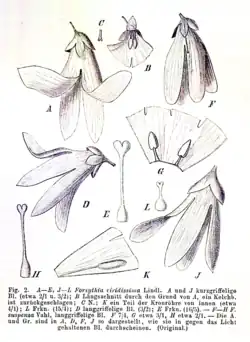Forsythia viridissima
| Forsythia viridissima | |
|---|---|
| April, Tokyo | |

| |
| Botanical illustration | |
| Scientific classification | |
| Kingdom: | Plantae |
| Clade: | Tracheophytes |
| Clade: | Angiosperms |
| Clade: | Eudicots |
| Clade: | Asterids |
| Order: | Lamiales |
| Family: | Oleaceae |
| Genus: | Forsythia |
| Species: | F. viridissima
|
| Binomial name | |
| Forsythia viridissima | |
| Synonyms[2] | |
| |
Forsythia viridissima, variously called the Chinese golden bell tree, green-stemmed forsythia, greenstem forsythia, and Korean forsythia, is a species of flowering plant in the genus Forsythia, native to southern China and South Korea, and introduced to Japan and the United States.[2][3] It flowers about two weeks later than other forsythias.[4] It may be of hybrid origin[5] and is believed to be one of the parents of Forsythia × intermedia.
References
- ^ J. Hort. Soc. London 1: 226 (1846)
- ^ a b "Forsythia viridissima Lindl". Plants of the World Online (POWO). Board of Trustees of the Royal Botanic Gardens, Kew. 2017. Retrieved 28 January 2021.
- ^ "Forsythia viridissima Chinese golden bell tree". The Royal Horticultural Society. Retrieved 28 January 2021.
- ^ "Green-stemmed forsythia". mortonarb.org. The Morton Arboretum. 2021. Retrieved 28 January 2021.
- ^ Ha, Young-Ho; Kim, Changkyun; Choi, Kyung; Kim, Joo-Hwan (2018). "Molecular Phylogeny and Dating of Forsythieae (Oleaceae) Provide Insight into the Miocene History of Eurasian Temperate Shrubs". Frontiers in Plant Science. 9: 99. Bibcode:2018FrPS...09...99H. doi:10.3389/fpls.2018.00099. PMC 5807412. PMID 29459880. S2CID 3376581.